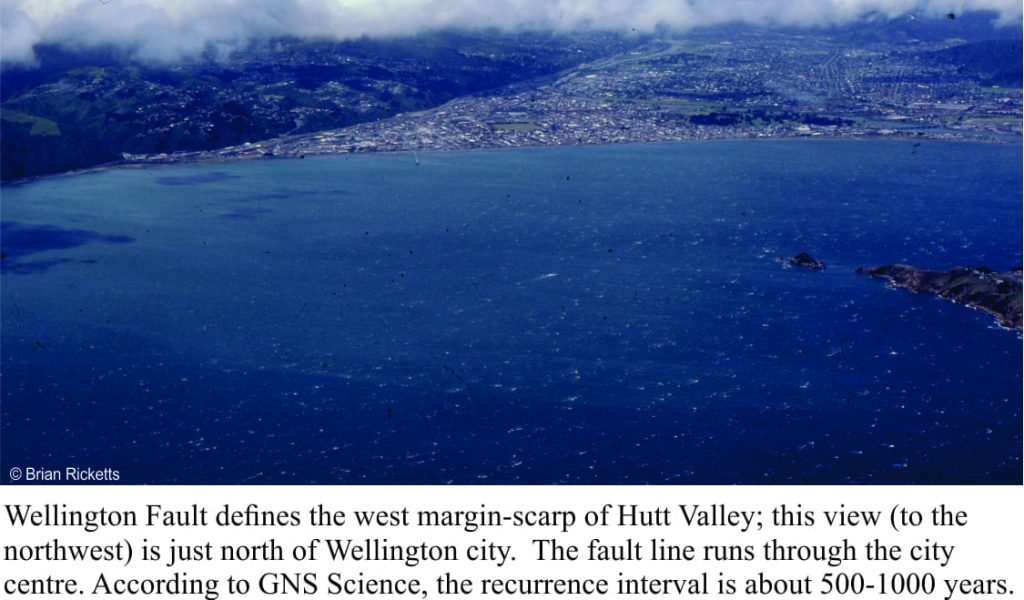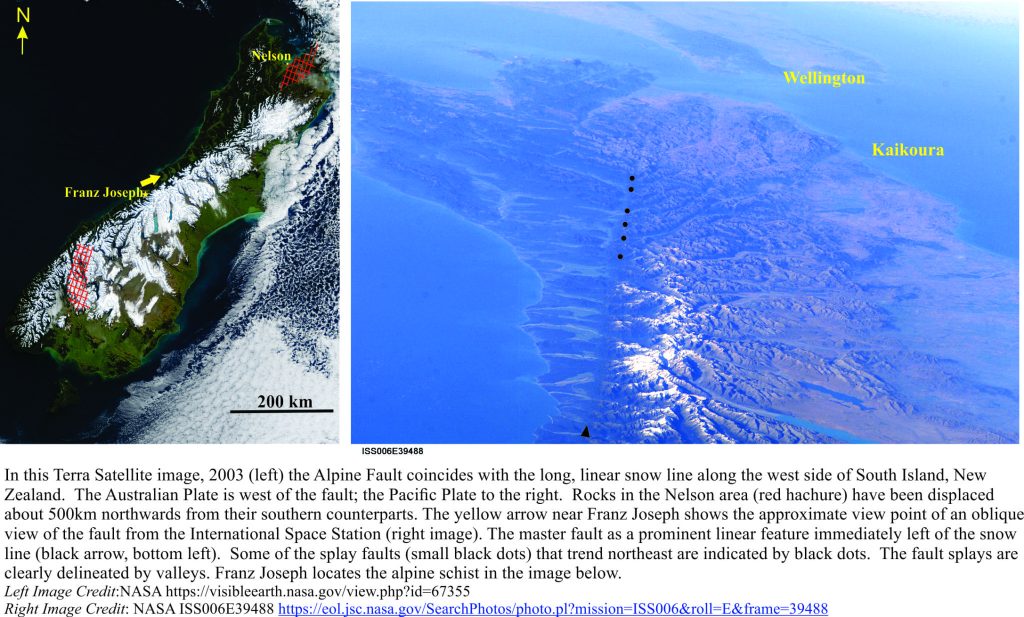In 1940-41, Harold Wellman, a creative but somewhat irreverent New Zealand geologist, along with his colleague Dick Willett, discovered a remarkably long, linear fault striking slightly oblique to, and a few kilometres landward of the South Island west coast; almost the entire length of the island. They called this massive structure the Alpine Fault. The Fault can be traced overland some 600 km, about 450km of this is a more-or-less single fault strand; at its northern extent the fault splits into several strands, all of which are active.
Most New Zealand geologists in the 1940s had little problem with a structure like this – admittedly it was very long, but most were familiar with faults, especially active ones. By 1948 it had generally been accepted by the scientific community. The community did however have an issue with Wellman’s next discovery. He realised that a certain group of rocks in the southern part of South Island (Otago region), were almost identical to a group at the north end of the Island (Nelson region). He postulated in 1949 that these two geological domains were once a contiguous unit but had been separated some 500km by the Alpine Fault. To many geologists at the time, this was going a bit too far, and it took several years to dispel the initial disbelief, and perhaps the odd conniption fit; one of the main criticisms was the absence of any reasonable mechanism to accomplish this geological feat. This was pre-Plate Tectonics, a time when many earth scientists still considered vertical movements of the earth’s crust to be the most important (although Alfred Wegener’s ideas on Continental Drift were discussed – it seems that Wellman was quite keen on this hypothesis). Fast forward to 1965 and a paper by J. Tuzo Wilson published in Nature, described a “New Class of Faults…”; Transform Faults. Wellman’s discovery was about to acquire a mechanism, and become an iconic part of the new Plate Tectonics.
All plates identified by Plate Tectonic theory have boundaries, of which there are three basic types:
- Spreading ridges and rifts, where upwelling magma creates new crust that moves away from the ridge,
- Deep ocean trenches where two plates converge, forming a subduction zone that recycles old crust and mantle, and
- Transform faults where two plates slide past one another. Most of this sliding is horizontal. If the movement between two massive slabs of crust and mantle were continuous then there would be few problems, other than a gradual (mm/year) change in one’s property boundary lines. But most movement along these fundamental structures is not continuous or uniform; it takes place in fits and starts – during earthquakes that commonly are very high magnitude, destructive events.
The Alpine Fault, and its close relative San Andreas Fault on the other side of the Pacific Ocean, are transform faults. They each mark a boundary between two plates – if you walk across the San Andreas fault you pass from the Pacific Plate to the American Plate; over the Alpine Fault, from the Pacific to the Australian Plate. There aren’t many places on earth where one can easily straddle two tectonic plates; these two transform faults provide great opportunities to become one with plate tectonics.
The Alpine Fault is geologically young. The 500-km fault separation of the two geological domains began about 25 million years ago; from a geological perspective, this is really fast – for tectonic plates. The west side of the fault moves northwards relative to the east side; it is referred to as a dextral (right-moving) strike-slip fault. At the same time, stresses acting 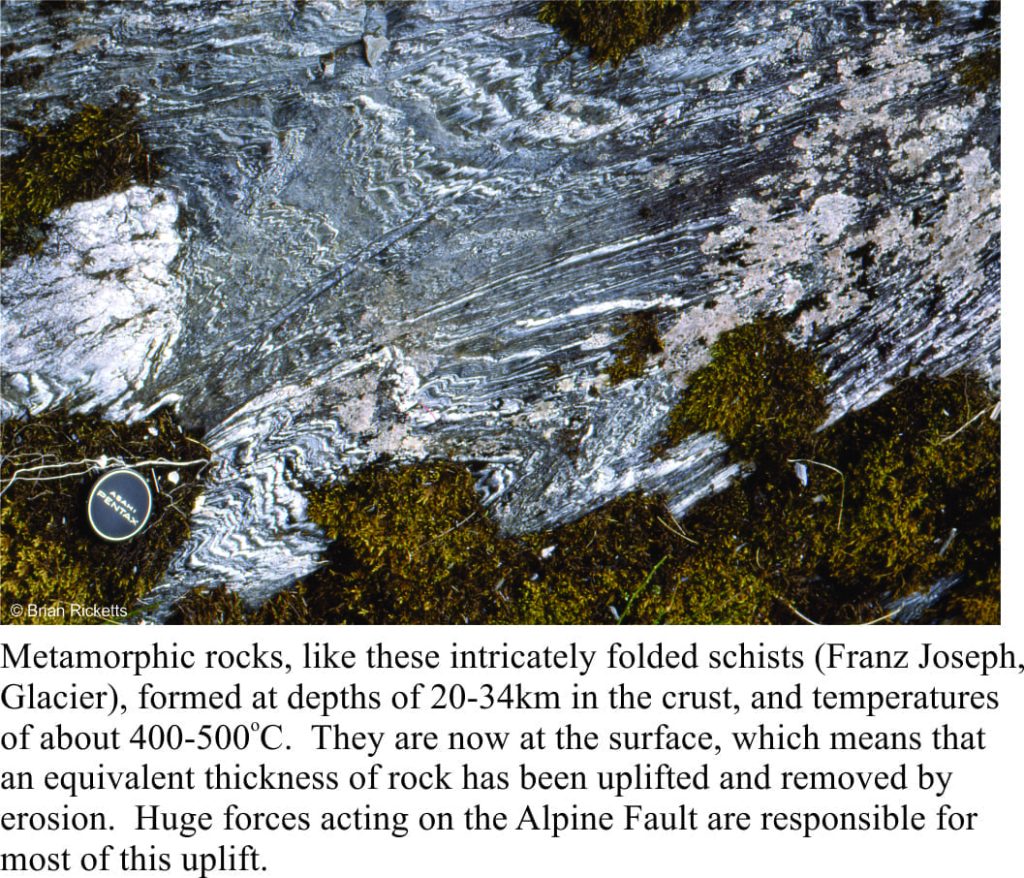 against the fault have uplifted the landmass; over the last 12 million years, rocks formerly 20-30km deep, were pushed to the surface, forming the Southern Alps. Coincidentally, erosion and glaciation have carved the landmass into the rugged mountain range that extends almost the full length of South Island. Averaged over the last 2 million years, the central part of the Alpine Fault has moved horizontally at a phenomenal 27mm/year, and vertically at 10mm/year. It is thought that this extreme displacement of the earth’s crust is the result of large, M (magnitude)7.5 to M8 earthquakes occurring every 200-400 years, the most recent in 1717AD.
against the fault have uplifted the landmass; over the last 12 million years, rocks formerly 20-30km deep, were pushed to the surface, forming the Southern Alps. Coincidentally, erosion and glaciation have carved the landmass into the rugged mountain range that extends almost the full length of South Island. Averaged over the last 2 million years, the central part of the Alpine Fault has moved horizontally at a phenomenal 27mm/year, and vertically at 10mm/year. It is thought that this extreme displacement of the earth’s crust is the result of large, M (magnitude)7.5 to M8 earthquakes occurring every 200-400 years, the most recent in 1717AD.
At its northern extent, the Alpine Fault splits into several large, active faults, some heading offshore, others into the southern North Island (the North Island Fault System) and these have been the focus of many destructive earthquakes in the M6 to M8 range. More than 6m of horizontal displacement registered the M7.8 event along Kekerengu Fault in November 2016 (Kaikoura earthquake). On January 23, 1855, up to 18m of horizontal displacement occurred during the Wairarapa Earthquake, estimated to have been M8.2 – M8.3. The epicentre was only a few kilometres south of Wellington city, which suffered significant damage although few fatalities; there was also a tsunami that in places had a 10-11m run-up.
San Andreas Fault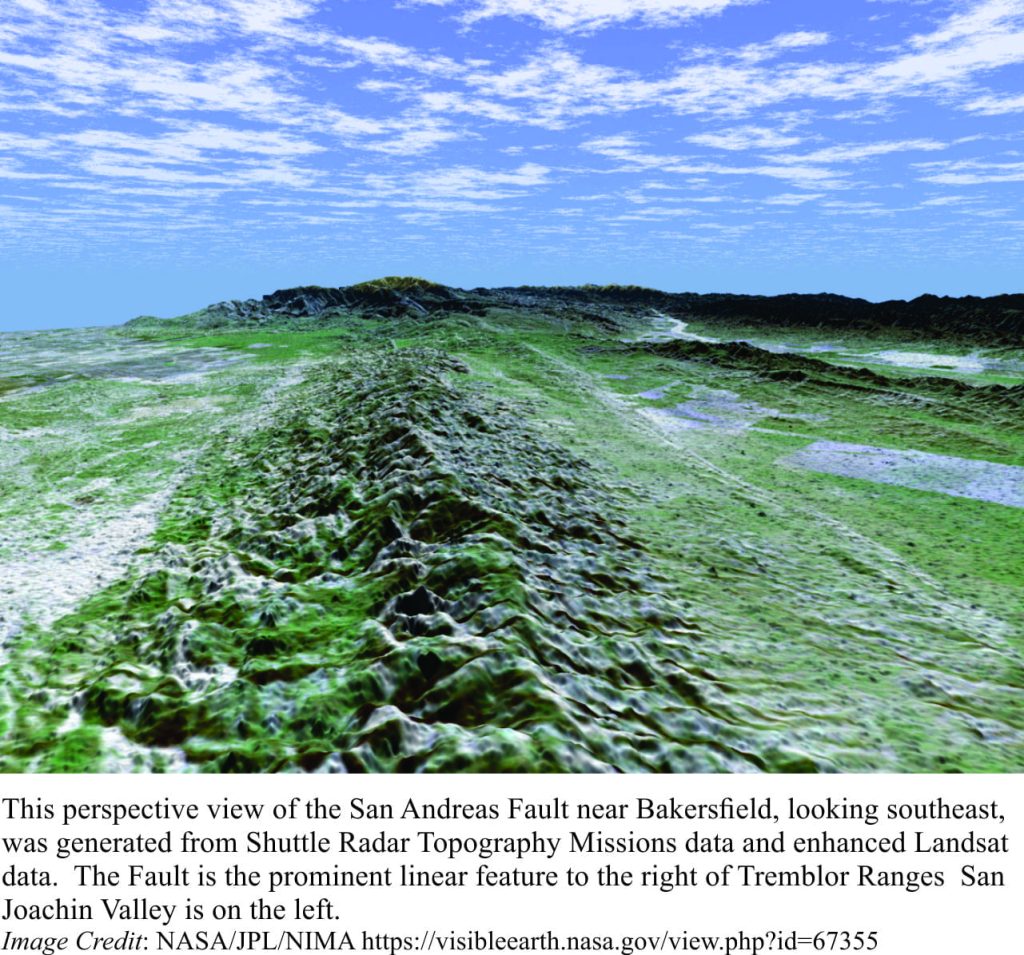 is another iconic example of earth’s major fractures, and probably the most intensely studied. It is about 1200km long, and like its New Zealand counterpart, consists of a master fault with many divergent, active and inactive fault strands. It began to move things around about 28 million years ago and has continued to do so ever since, coming to public prominence on April 18,1906 with the San Francisco M7.7 to M7.9 earthquake (and subsequent conflagration); one of the largest events along this fault. Earthquake recurrence intervals vary along the San Andreas fault system; in the southern part it averages about 150 years, but in some fault segments like Big Bend, it may be as low as 100 years.
is another iconic example of earth’s major fractures, and probably the most intensely studied. It is about 1200km long, and like its New Zealand counterpart, consists of a master fault with many divergent, active and inactive fault strands. It began to move things around about 28 million years ago and has continued to do so ever since, coming to public prominence on April 18,1906 with the San Francisco M7.7 to M7.9 earthquake (and subsequent conflagration); one of the largest events along this fault. Earthquake recurrence intervals vary along the San Andreas fault system; in the southern part it averages about 150 years, but in some fault segments like Big Bend, it may be as low as 100 years.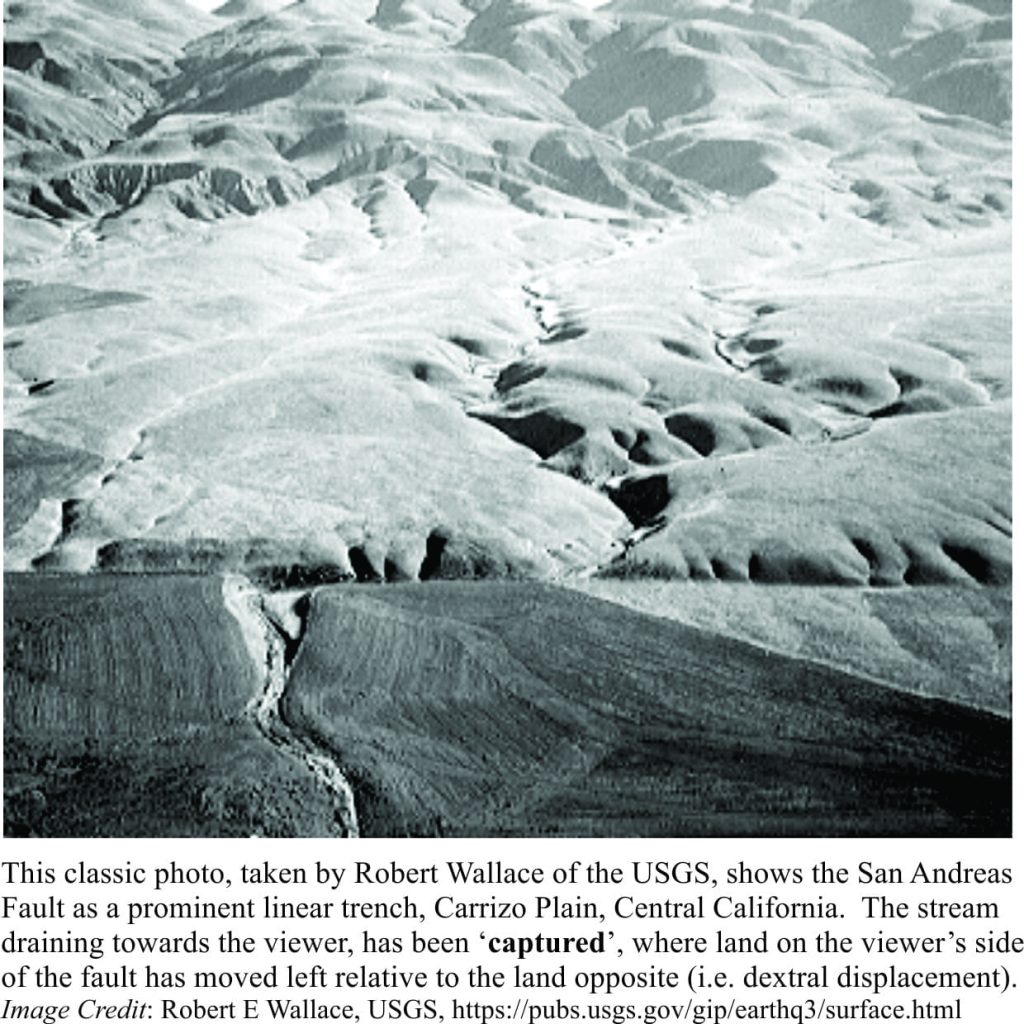 A commonly used method for estimating earthquake recurrence interval is to date young sediments that have accumulated close to faults. Silts and muds that accumulate in river or lake beds will frequently contain peats or fossil soils, layers of woody material, and sometimes volcanic ash; along coasts, beach deposits may be raised by successive earthquakes, and these too may contain shells, wood or bone. These materials can be dated using carbon-14 and other dating techniques. The trick is to find layers that show some disturbance (for example from ground shaking, or displacement by actual faults) and then determine their age. There is always a fair degree of slop in recurrence numbers, a bit like predicting 1-in-500-year flood events (you might end up with 2 events in the space of 12 months!).
A commonly used method for estimating earthquake recurrence interval is to date young sediments that have accumulated close to faults. Silts and muds that accumulate in river or lake beds will frequently contain peats or fossil soils, layers of woody material, and sometimes volcanic ash; along coasts, beach deposits may be raised by successive earthquakes, and these too may contain shells, wood or bone. These materials can be dated using carbon-14 and other dating techniques. The trick is to find layers that show some disturbance (for example from ground shaking, or displacement by actual faults) and then determine their age. There is always a fair degree of slop in recurrence numbers, a bit like predicting 1-in-500-year flood events (you might end up with 2 events in the space of 12 months!).
Serious earthquakes are a fact of life on transform faults; after all, what do you expect when 10-20 kilometre-thick slabs of rock slide past one another. Recurrence numbers for major events (greater than M6 or M7) may have annoying statistical variation, but they are based on sound science. The sensible lessons learned when someone else’s backyard is reduced to rubble, like – be prepared, or, let’s do more science – are all too quickly forgotten. I guess it’s easier to point fingers after the fact, than to be on constant alert.
J Tuzo Wilson’s 1965 paper A new Class of Faults and their Bearing on Continental Drift was published in Nature, v.207, p.343-347.
